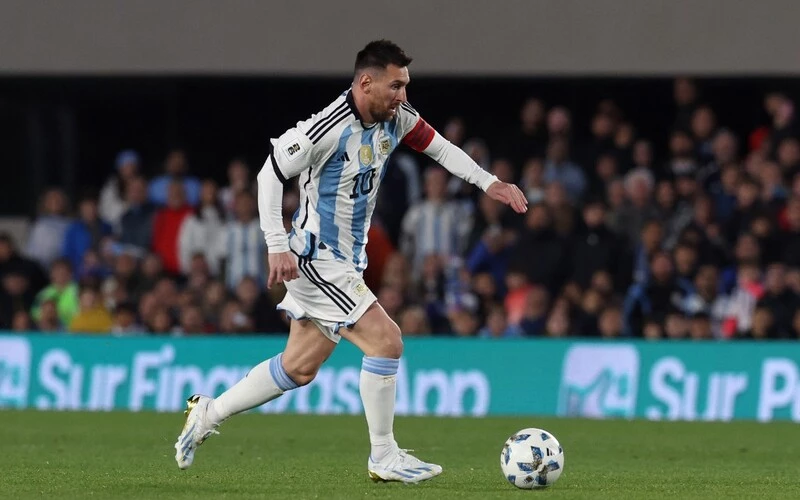FIFA Women’s World Cup
![]()
- Matchup Game: SF A vs SF B
- Date: Aug 20th, 2023
- Time: 5:00 AM ET
- Stadium: Stadium Australia, Sydney
- Champion: Spain
The 2023 FIFA Women’s World Cup is the ninth edition of the tournament, and it is being jointly hosted by Australia and New Zealand. It is the first time in the history of the Women’s World Cup that there are multiple host nations. The tournament is taking place from 20 July to 20 August 2023, with matches held across various cities in both countries.
The opening match of the tournament was held between New Zealand and Norway at Eden Park in Auckland on 20 July 2023. Despite a shooting incident in Auckland earlier in the day, the match proceeded as planned, as the players were unaffected and felt safe throughout the police operation. The New Zealand Prime Minister, Chris Hipkins, assured everyone that the incident posed no national security threat, and that the tournament would proceed with an active police presence to provide reassurance.
The opening match of the tournament was held between New Zealand and Norway at Eden Park in Auckland on 20 July 2023.
The final match of the 2023 Women’s World Cup is scheduled to take place on August 20th, 2023 at the Sydney Olympic Stadium in Sydney, Australia.
This edition of the Women’s World Cup features an expanded format with 32 teams, up from the previous 24, similar to the men’s World Cup format used from 1998 to 2022 . The defending champions are the United States, who have won the previous two tournaments in 2015 and 2019.
2023 Women's World Cup Odds
| Country | Odds *Last updated: 21/07/23 |
|---|---|
| United States | +250 |
| England | +350 |
| Spain | +450 |
| Germany | +650 |
| France | +1000 |
| Australia | +1200 |
| Sweden | +1400 |
| Netherlands | +2000 |
| Brazil | +2500 |
| Canada | +3500 |
| Japan | +3500 |
| Norway | +4000 |
| Denmark | +6500 |
| Italy | +8000 |
| New Zealand | +15000 |
| China | +15000 |
How To Read Women's World Cup Odds
To read up on the Women’s World Cup odds and bet on the 2023 Women’s World Cup, you can follow these steps:
Understand the odds:
Odds represent the probability of an event occurring and the potential payout if you win the bet. In most cases, odds are presented in three formats: decimal, fractional, or moneyline. Odds can fluctuate based on the teams' performance, injuries, and other factors. Compare the odds offered by different sportsbooks to find the best value for your bets.
Explore the betting options:
Sportsbooks provide several betting options for the Women's World Cup, including outright winners, match winners, goal scorers, and prop bets. You can bet on individual matches, group stage outcomes, or overall tournament winners.
Consider favorites and underdogs:
Favorites are teams that are expected to perform well and have higher chances of winning. Underdogs are teams with lower expectations but can offer higher potential payouts if they perform better than expected.
Research the teams and players:
Stay updated on the latest news, team form, player injuries, and previous performances to make informed betting decisions. Consider factors like team strategies, playing styles, and head-to-head records.
Manage your bankroll:
Set a budget for your bets and avoid exceeding it. Bet responsibly and only wager what you can afford to lose.
Place your bets:
Once you have done your research and selected your betting options, place your bets through your chosen sportsbook. Follow the instructions provided by the platform to complete the betting process.
2023 FIFA Women's World Cup Schedule
The match schedule was announced by FIFA on December 1st, 2021,with kick-off times confirmed on October 24th, 2022, two days after the final draw.
The opening match of the tournament, with co-hosts New Zealand going against Norway, was played on July 20th at Eden Park. The inaugural match in Australia, with co-hosts Australia vs Republic of Ireland, takes place on the same day at Stadium Australia, after a venue change due to strong ticketing demand.
The group stage fixtures will be split between the co-hosts, with New Zealand hosting Groups A, C, E and G, and Australia for Groups B, D, F and H. The third-place match will be played at Lang Park on 19 August, with the final to be played at Stadium Australia on 20 August.
Women's WC Matches by Groups
- New Zealand vs Norway | Date: Jul 20, 2023 | Stadium: Eden Park | Time: 4:00 AM ET
- Philippines vs Switzerland | Date: Jul 21, 2023 | Stadium: Dunedin Stadium | Time: 2:00 AM ET
- New Zealand vs Philippines | Date: Jul 25, 2023 | Stadium: Wellington Regional Stadium | Time: 2:30 AM ET
- Switzerland vs Norway | Date: Jul 25, 2023 | Stadium: Waikato Stadium | Time: 5:00 AM ET
- Norway vs Philippines | Date: Jul 30, 2023 | Stadium: Eden Park | Time: 4:00 AM ET
- Switzerland vs New Zealand | Date: Jul 30, 2023 | Stadium: Dunedin Stadium | Time: 4:00 AM ET
- Australia vs Republic of Ireland | Date: Jul 20, 2023 | Stadium: Stadium Australia | Time: 7:00 AM ET
- Canada vs Republic of Ireland | Date: Jul 23, 2023 | Stadium: Perth Rectangular Stadium | Time: 9:00 AM ET
- USA vs Netherlands | Date: Jul 27, 2023 | Stadium: Wellington Regional Stadium | Time: 10:00 PM ET
- Australia vs Nigeria | Date: Jul 27, 2023 | Stadium: Brisbane Stadium | Time: 7:00 AM ET
- Canada vs Australia | Date: Jul 31, 2023 | Stadium: Melbourne Rectangular Stadium | Time: 7:00 AM ET
- Republic of Ireland vs Nigeria | Date: Jul 31, 2023 | Stadium: Brisbane Stadium | Time: 7:00 AM ET
- Spain vs Costa Rica | Date: Jul 21, 2023 | Stadium: Wellington Regional Stadium | Time: 4:30 AM ET
- Zambia vs Japan | Date: Jul 22, 2023 | Stadium: Waikato Stadium | Time: 4:00 AM ET
- Spain vs Zambia | Date: Jul 26, 2023 | Stadium: Eden Park | Time: 4:30 AM ET
- Japan vs Costa Rica | Date: Jul 26, 2023 | Stadium: Dunedin Stadium | Time: 2:00 AM ET
- Japan vs Spain | Date: Jul 31, 2023 | Stadium: Wellington Regional Stadium | Time: 4:00 AM ET
- Costa Rica vs Zambia | Date: Jul 31, 2023 | Stadium: Waikato Stadium | Time: 4:00 AM ET
- England vs Haiti | Date: Jul 22, 2023 | Stadium: Brisbane Stadium | Time: 6:30 AM ET
- Denmark vs China | Date: Jul 22, 2023 | Stadium: Perth Rectangular Stadium | Time: 9:00 AM ET
- England vs Denmark | Date: Jul 28, 2023 | Stadium: Sydney Football Stadium | Time: 5:30 AM ET
- China vs Haiti | Date: Jul 28, 2023 | Stadium: Hindmarsh Stadium | Time: 8:30 AM ET
- Haiti vs Denmark | Date: Aug 1, 2023 | Stadium: Perth Rectangular Stadium | Time: 8:00 AM ET
- China vs England | Date: Aug 1, 2023 | Stadium: Hindmarsh Stadium | Time: 7:30 AM ET
- United States vs Vietnam | Date: Jul 22, 2023 | Stadium: Eden Park | Time: 10:00 PM ET
- Portugal vs Vietnam | Date: Jul 27, 2023 | Stadium: Waikato Stadium | Time: 4:30 AM ET
- Portugal vs USA | Date: Aug 1, 2023 | Stadium: Eden Park | Time: 4:00 AM ET
- Vietnam vs Netherlands | Date: Aug 1, 2023 | Stadium: Dunedin Stadium | Time: 4:00 AM ET
- USA vs Netherlands | Date: Aug 2, 2023 | Stadium: Wellington Regional Stadium | Time: 10:00 PM ET
- Portugal vs Vietnam | Date: Aug 2, 2023 | Stadium: Waikato Stadium | Time: 4:00 AM ET
- France vs Jamaica | Date: Jul 23, 2023 | Stadium: Sydney Football Stadium | Time: 9:00 AM ET
- France vs Brazil | Date: Jul 29, 2023 | Stadium: Brisbane Stadium | Time: 7:00 AM ET
- Panama vs Jamaica | Date: Jul 29, 2023 | Stadium: Perth Rectangular Stadium | Time: 7:30 AM ET
- Panama vs France | Date: Aug 2, 2023 | Stadium: Sydney Football Stadium | Time: 7:00 AM ET
- Jamaica vs Brazil | Date: Aug 2, 2023 | Stadium: Melbourne Rectangular Stadium | Time: 7:00 AM ET
- France vs Jamaica | Date: Aug 3, 2023 | Stadium: Sydney Football Stadium | Time: 4:00 AM ET
- Sweden vs South Africa | Date: Jul 23, 2023 | Stadium: Wellington Regional Stadium | Time: 2:00 AM ET
- Italy vs Argentina | Date: Jul 24, 2023 | Stadium: Eden Park | Time: 3:00 AM ET
- Argentina vs Sweden | Date: Jul 29, 2023 | Stadium: Waikato Stadium | Time: 4:00 AM ET
- South Africa vs Italy | Date: Jul 29, 2023 | Stadium: Wellington Regional Stadium | Time: 4:00 AM ET
- Argentina vs Sweden | Date: Aug 2, 2023 | Stadium: Waikato Stadium | Time: 4:00 AM ET
- South Africa vs Italy | Date: Aug 2, 2023 | Stadium: Wellington Regional Stadium | Time: 4:00 AM ET
- Germany vs Morocco | Date: Jul 24, 2023 | Stadium: Melbourne Rectangular Stadium | Time: 4:30 AM ET
- South Korea vs Morocco | Date: Jul 30, 2023 | Stadium: Hindmarsh Stadium | Time: 5:00 AM ET
- Germany vs Colombia | Date: Jul 30, 2023 | Stadium: Eden Park | Time: 4:30 AM ET
- South Korea vs Germany | Date: Aug 2, 2023 | Stadium: Brisbane Stadium | Time: 5:00 AM ET
- Morocco vs Colombia | Date: Aug 3, 2023 | Stadium: Perth Rectangular Stadium | Time: 1:00 AM ET
- South Korea vs Colombia | Date: Aug 3, 2023 | Stadium: Hindmarsh Stadium | Time: 5:00 AM ET
- Group A Winner vs Group C Runner-up | Date: Aug 5, 2023 | Stadium: Eden Park | Time: 2:00 AM ET
- Group C Winner vs Group A Runner-up | Date: Aug 5, 2023 | Stadium: Wellington Regional Stadium | Time: 5:00 AM ET
- Group E Winner vs Group G Runner-up | Date: Aug 6, 2023 | Stadium: Sydney Football Stadium | Time: 11:00 PM ET
- Group G Winner vs Group E Runner-up | Date: Aug 6, 2023 | Stadium: Melbourne Rectangular Stadium | Time: 6:00 AM ET
- Group B Winner vs Group D Runner-up | Date: Aug 7, 2023 | Stadium: Brisbane Stadium | Time: 4:30 AM ET
- Group D Winner vs Group B Runner-up | Date: Aug 7, 2023 | Stadium: Stadium Australia, Sydney | Time: 7:30 AM ET
- Group H Winner vs Group F Runner-up | Date: Aug 8, 2023 | Stadium: Melbourne Rectangular Stadium | Time: 5:00 AM ET
- Group F Winner vs Group H Runner-up | Date: Aug 8, 2023 | Stadium: Hindmarsh Stadium | Time: 8:00 AM ET
- RO16 2 vs RO16 4 | Date: Aug 11, 2023 | Stadium: Wellington Regional Stadium | Time: 4:30 AM ET
- RO16 1 vs RO16 3 | Date: Aug 11, 2023 | Stadium: Eden Park | Time: 10:00 PM ET
- RO16 5 vs RO16 7 | Date: Aug 12, 2023 | Stadium: Brisbane Stadium | Time: 4:00 AM ET
- RO16 6 vs RO16 8 | Date: Aug 12, 2023 | Stadium: Stadium Australia | Time: 8:30 AM ET
- QF A vs QF B | Date: Aug 15, 2023 | Stadium: Eden Park | Time: 5:00 AM ET
- QF C vs QF D | Date: Aug 16, 2023 | Stadium: Stadium Australia | Time: 7:00 AM ET
Third Place Play-off
- Losers: SF A vs SF B | Date: Aug 19, 2023 | Stadium: Lang Park, Brisbane | Time: 7:00 AM ET
Final
- Winners: SF A vs SF B | Date: Aug 20, 2023 | Stadium: Stadium Australia, Sydney | Time: 5:00 AM ET
2023 Women's World Cup Host Selection
The host selection process for the 2023 FIFA Women’s World Cup began on February 19th, 2019, with member associations expressing interest in hosting the tournament. Initially, nine countries indicated their interest: Argentina, Australia, Bolivia, Brazil, Colombia, Japan, South Korea (with interest in a joint bid with North Korea), New Zealand, and South Africa. However, some countries later withdrew their bids.
Australia and New Zealand decided to merge their bids and submitted a joint bid to host the tournament. In December 2019, Brazil, Colombia, and Japan also submitted their bid books to FIFA. Ultimately, Brazil and Japan withdrew their bids in June 2020 before the final voting took place.
On 25 June 2020, Australia and New Zealand were selected as the hosts for the 2023 Women’s World Cup. This decision was made by the FIFA Council, with Australia and New Zealand winning 22 votes, while Colombia received 13 votes.
It is noteworthy that this will be the first Women’s World Cup to be hosted in multiple countries, with matches taking place in both Australia and New Zealand. Additionally, it marks the first time a senior FIFA tournament is held in Oceania and the Southern Hemisphere. The tournament will also be hosted across multiple confederations, with Australia in the AFC and New Zealand in the OFC. Australia becomes the second AFC association to host the Women’s World Cup after China, which hosted the tournament in 1991 and 2007.
The successful bid by Australia and New Zealand set the stage for an exciting and groundbreaking Women’s World Cup in 2023.
Women's World Cup Stadiums
The opening match of the tournament was held at Eden Park in Auckland, New Zealand, and the final match will be hosted at Stadium Australia in Sydney, Australia. Other significant matches, such as the third-place match, will be held at Lang Park in Brisbane.
These venues were selected from the proposed list, which initially included 13 possible venues across 12 host cities. The final selection considered factors such as capacity, infrastructure, and meeting FIFA’s hosting requirements.
The host cities and venues for the 2023 Women’s World Cup provide a diverse range of locations, allowing fans from different regions to participate in and enjoy the tournament’s matches.
The 2023 FIFA Women’s World Cup will be hosted by Australia and New Zealand, with matches taking place in various cities across the two countries. Here are the host cities and venues for the tournament:
Adelaide – Hindmarsh Stadium (16,500 capacity)
Brisbane (Meaanjin) – Lang Park (52,500 capacity)
Melbourne (Naarm) – Melbourne Rectangular Stadium (30,000 capacity)
Perth – Perth Oval (20,500 capacity)
Sydney (Gadigal) – Stadium Australia (70,000 capacity)
Sydney Football Stadium (42,000 capacity)
- Auckland (Tamaki Makaurau) – Eden Park (50,000 capacity)
- Dunedin (Otepoti) – Dunedin Stadium (30,000 capacity)
- Hamilton – Waikato Stadium (25,800 capacity)
- Wellington (Te Whanganui-a-Tara) – Wellington Regional Stadium (35,000 capacity)
Women’s World Cup: A Historical Evolution of Prestige
The Women’s World Cup is a prestigious international football tournament organized by FIFA for senior women’s national teams. It is held every four years, following the men’s World Cup by one year.
The inaugural tournament took place in 1991 in China, and it has since grown in popularity and scale. The 2023 edition marks the first time the Women’s World Cup is co-hosted by two countries, spanning multiple confederations. It is also the first seniors tournament held in Oceania and the first Women’s World Cup in the Southern Hemisphere.
The tournament follows a format of eight round-robin groups, followed by a knockout round involving 16 teams. The United States is the reigning champion, having defeated the Netherlands 2-0 in the final of the 2019 FIFA Women’s World Cup.
FIFA Women's Rankings
The current FIFA Women’s World Rankings provide an overview of the teams’ form leading up to the 2023 Women’s World Cup in Australia and New Zealand. The rankings play a significant role in determining seedings and group compositions for major tournaments like the World Cup.
As of the latest ranking release on June 9, 2023, the top-ranked team is the United States, the defending world champions, who have held the top spot continuously since 2017. Germany, who previously had a long spell at the top between 2003 and 2007, is currently ranked second. The other top-ranked teams in the tournament include Sweden, England, France, Spain, Canada, Brazil, Netherlands, and Australia.
It’s worth noting that the FIFA Women’s World Rankings are based on several factors, including the results of international matches, the importance of matches, the strength of opponents, and recentness of the matches. To be ranked, a team must have played at least five matches, with at least one match played within the previous 18 months.
While the top-ranked team in the FIFA Women’s World Rankings does not always win the tournament, it is still an indicator of a team’s overall performance and standing in women’s international football. The rankings provide valuable information in assessing team strengths and evaluating their chances in major competitions.
Women's World Cup Team Qualification
The qualification process for the 2023 FIFA Women’s World Cup involved various continental championships and qualifying competitions organized by FIFA’s confederations.
In total, there were 29 direct slots allocated to the qualified teams, with the remaining 3 slots decided through a play-off tournament.
Here is an overview of the teams and qualification process:
- Australia and New Zealand qualified automatically as co-hosts of the tournament.
- AFC: 2 slots
- CAF: 2 slots
- CONCACAF: 2 slots
- CONMEBOL: 2 slots
- OFC: 1 slot
- UEFA: 1 slot
- The qualification process involved teams from 172 FIFA member associations.
- Several teams withdrew or were suspended, including Chad, Pakistan, Rwanda, Sudan, DR Congo, São Tomé and Príncipe, Kenya, North Korea, Turkmenistan, Iraq, Afghanistan, India, American Samoa, and Russia.
- The remaining teams competed in continental championships and qualifying competitions to secure their spots in the tournament.
- Teams like Haiti, Morocco, Panama, the Philippines, Portugal, the Republic of Ireland, Vietnam, and Zambia qualified for their first-ever FIFA Women’s World Cup.
- Iceland, ranked 16th in the FIFA Women’s World Rankings at the time, failed to qualify, while Zambia, ranked 81st, qualified for the tournament.
- The qualification process aimed to determine 30 of the 32 teams participating in the 2023 FIFA Women’s World Cup, with Australia and New Zealand qualifying automatically as co-hosts. The teams went through continental championships and qualifying competitions, with 29 direct slots and 3 playoff slots allocated to the qualified teams. The tournament will feature a diverse mix of teams, including debutants and teams returning after missing previous editions.





























